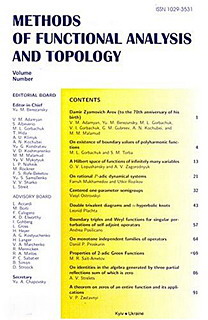Methods of Functional Analysis
and Topology
Editors-in-Chief: A. N. Kochubei,
G. M. Torbin
ISSN: 1029-3531 (Print), 2415-7503 (Online)
Founded by Yu. M. Berezansky in 1995.
Methods of Functional Analysis and Topology (MFAT), founded in 1995, is a peer-reviewed journal publishing original articles and surveys on general methods and techniques of functional analysis and topology with a special emphasis on applications to modern mathematical physics.
MFAT is an open access journal, free for authors and free for readers.
Indexed in: MathSciNet, zbMATH, Scopus, Web of Science, DOAJ, Google Scholar
Latest Articles (September, 2023)
Spaces of Continuous and Measurable Functions Invariant Under a Group Action
MFAT 29 (2023), no. 3-4, 94-100
94-100
In this paper we characterize spaces of continuous and
$L^p$-functions on a compact Hausdorff space that are invariant
under a transitive and continuous group action. This work
generalizes Nagel and Rudin's 1976 results concerning unitarily and
Möbius invariant spaces of continuous and measurable functions
defined on the unit sphere in $\mathbb{C}^n.$
У статті ми характеризуємо простори неперервних і
$L^p$-функцій на компакті, які є інваріантними відносно неперервної
та транзитивної дії групи. Робота узагальнює результати Нагеля і
Рудіна 1976 року про інваріантні простори неперервних і вимірних
функцій визначений на одиничній сфері в $\mathbb{C}^n$ відносно дій
унітарної групи та групи Мебіуса.
Second degree semiclassical linear functionals of class one. The quasi-antisymmetric case
MFAT 29 (2023), no. 3-4, 134-144
134-144
An orthogonal sequence with respect to a regular linear functional
$w$ is said to be semiclassical if there exist a monic polynomial
$\Phi$ and a polynomial $\Psi$ with $\deg(\Psi)\geq1$, such that
$(\Phi w)^{'}+\Psi w=0$. Recently, all semiclassical monic
orthogonal polynomial sequences of class one satisfying a three term
recurrence relation with $\beta_{0}=-\alpha_{0}$,
$\beta_{n+1}=\alpha_{n}-\alpha_{n+1}$ and
$\gamma_{n+1}=-\alpha_{n}^{2}$ with $ \alpha_{n}\neq0\,,\;n\geq0,$
have been determined [17].
In this paper, we point sequences of the above family such that
their corresponding Stieltjes function
$S(w)(z)=-\displaystyle\sum_{n\geq0}\frac{(w)_{n}}{z^{n+1}}$
satisfies a quadratic equation $B(z)S^{2}(w)(z)+C(z)S(w)(z)+D(z)=0$,
where $B$, $C$, $D$ are polynomials.
Ортогональна послідовність відносно регулярного лінійного
функціонала $w$ називається напівкласичною, якщо існує моном $\Phi$
і поліном $\Psi$, $\deg(\Psi)\geq1$, такі, що
$(\Phi w)^{'}+\Psi w=0$. Останнім часом всі напівкласичні монічні
ортогональні поліноміальні послідовності першого класу, що
задовольняють тричленному рекурентному відношенню, коли
$\beta_{0}=-\alpha_{0}$, $\beta_{n+1}=\alpha_{n}-\alpha_{n+1}$ і
$\gamma_{n+1}=-\alpha_{n}^{2}$ з $ \alpha_{n}\neq0$, $n\geq0,$ були
визначені [17].
В статті вказуються послідовності вищевказаної сім'ї такі, що їх
відповідна функція Стілтьєса
$S(w)(z)=-\displaystyle\sum_{n\geq0}\frac{(w)_{n}}{z^{n+1}}$
задовольняє квадратичному рівнянню
$B(z)S^{2}(w)(z)+C(z)S(w)(z)+D(z)=0$, де $B$, $C$, $D$ -- поліноми.
New optical solutions for the Wu-Zhang system with time fractional conformable derivative
Kamal Ait Touchent, J. El Amrani, Rachid Bahloul
MFAT 29 (2023), no. 3-4, 125-133
125-133
In this paper, the sine-Gordon expansion method is implemented to
obtain new explicit solutions for the nonlinear Wu-Zhang system with
a time-fractional conformable derivative. The solutions constructed
are plotted with the Maple software and expressed by three types of
functions: hyperbolic function solution, exponential function
solution and trigonometric function solution. The nonlinear
fractional partial differential equation is converted into an
ordinary differential equation of integer order. This method is used
to solve a fractional Wu-Zhang system. These solutions might be
important and highly useful in various scientific fields. It is
shown that this method is very efficient for constructing exact
solutions of nonlinear fractional partial differential equations.
Реалізовано метод розширення синус-Гордона для отримання
нових явних розв'язків для нелінійної системи Ву-Жанга із
дробове-конформною похідною за часом. Отримані розв'язки будуються
за допомогою програмного забезпечення Maple і виражаються трьома
типами функцій: гіперболічними функціями, показниковими
функціями та тригонометричними функціями. Нелінійне диференціальне
рівняння з дробовими похідними перетворюється в звичайне
диференціальне рівняння з цілим порядком. Цей метод
використовується для розв’язку системи У-Чжан з дробовими похідними.
Рішення можуть бути важливими і дуже корисними у різних галузях
науки. Показано, що це метод є дуже ефективним для побудови точних
розв'язків нелінійних рівнянь з дробовими похідними.
Weaving operator Frames for $B(\mathcal{H})$
Mohamed Rossafi, Khadija Mabrouk, M'hamed Ghiati, Mohammed Mouniane
MFAT 29 (2023), no. 3-4, 111-124
111-124
This paper aims to study the concept of weaving operator frames
within Hilbert spaces $\mathcal{H}$. Properties of weaving operator
frames are explored. An investigation into the dual aspect of
weaving operator frames within $B(\mathcal{H})$ spaces is presented.
The behavior and characteristics of weaving operator responses
within the context of Hilbert spaces are discuted. Finally,
perturbation results concerning weaving operator frames are
obtained.
В статті вивчається концепція фреймів сплітаючих операторів
в гільбертових просторах $\mathcal{H}$. Досліджуються властивості
фреймів сплітаючих операторів. Вивчено подвійний аспект фреймів
сплітаючих операторів в просторах $B(\mathcal{H})$. Обговорено
поведінку та характеристики реакцій сплітаючего оператора в
контексті гільбертових просторів. Отримано результати збурення
фреймів сплітаючих операторів.

